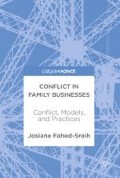Abstract
This chapter introduces conflict. It starts with the various definitions of conflict and the way it develops. Then the roles of conflict including both the positive and negative outcomes are discussed. Later, the causes of conflict in an organization are highlighted while discussing the different modules and types of conflict. Finally, the processes and stages through which conflict passes are further deliberated.
Access this chapter
Tax calculation will be finalised at checkout
Purchases are for personal use only
References
Afzalur Rahim, M. 2002. Toward a theory of managing organizational conflict. International Journal of Conflict Management 13 (3): 206–235.
Amason, A.C., and D.M. Schweiger. 1994. Resolving the paradox of conflict, strategic decision making, and organizational performance. International Journal of Conflict Management 5 (3): 239–253.
Amason, A.C. 1996. Distinguishing the effects of functional and dysfunctional conflict on strategic decision making: Resolving a paradox for top management teams. Academy of Management Journal 39 (1): 123–148.
Antonioni, D. 1998. Relationship between the big five personality factors and conflict management styles. International journal of conflict management 9 (4): 336–355.
Blake, R.R., and J.S. Mouton. 1985. The managerial grid III: The key to leadership excellence.
Brahnam, S.D., T.M. Margavio, M.A. Hignite, T.B. Barrier, and J.M. Chin. 2005. A gender-based categorization for conflict resolution. Journal of management development 24 (3): 197–208.
Brehmer, B. 1976. Social judgment theory and the analysis of interpersonal conflict. Psychological Bulletin 83 (6): 985.
Brown, L.D. 1995. Managing conflict among groups. The organizational behaviour reader, 6 ed., 317–328. Englewood Cliffs, NJ: Prentice-Hall.
Burton, J., and F. Dukes. (eds.). 1990. Conflict: Readings in management and resolution. London: Springer.
Carnevale, P.J., and A.M. Isen. 1986. The influence of positive affect and visual access on the discovery of integrative solutions in bilateral negotiation. Organizational Behavior and Human Decision Processes 37 (1): 1–13.
Conflict Management and Negotiation—Strategy, organization, levels, style, advantages, manager, definition, company, disadvantages (2016). Referenceforbusiness.com. http://www.referenceforbusiness.com/management/Comp-De/Conflict-Management-and-Negotiation.html. Accessed 19 Aug 2016.
Cox, T.H., and S. Blake. 1991. Managing cultural diversity: Implications for organizational competitiveness. The Executive 5 (3): 45–56.
Darling, J.R., and C.E. Fogliasso. 1999. Conflict management across cultural boundaries: a case analysis from a multinational bank. European Business Review 99 (6): 383–392.
De Dreu, C.K., and E. Vliert van de. (eds.). 1997. Using conflict in organizations. Thousand Oaks: Sage.
De Dreu, C.K., and A.E. Van Vianen. 2001. Managing relationship conflict and the effectiveness of organizational teams. Journal of Organizational Behavior 22 (3): 309–328.
Digvijaysinh Thakore, D. 2013. Conflict and conflict management. IOSR Journal of Business And Management 8 (6): 7–16. http://dx.doi.org/10.9790/487x-0860716.
DuBrin, A.J. 1972. Practice of managerial psychology. Oxford: Pergamon Press.
Eunson, B. 2012. Conflict management. Hoboken: Wiley.
Glaser, C.L. 2000. The causes and consequences of arms races. Annual Review of Political Science 3 (1): 251–276.
Hall, J., and M.S. Williams. 1966. A comparison of decision-making performances in established and ad hoc groups. Journal of Personality and Social Psychology 3 (2): 214.
Hoffman, L.R. 1959. Homogeneity of member personality and its effect on group problem-solving. The Journal of Abnormal and Social Psychology 58 (1): 27.
Janis, I.L. 1972. Victims of groupthink: A psychological study of foreign-policy decisions and fiascoes. Boston: Houghton Mifflin Company.
Jehn, K.A. 1995. A multimethod examination of the benefits and detriments of intragroup conflict. Administrative science quarterly 40 (2): 256–282.
Jehn, K.A. 1997a. Affective and cognitive conflict in work groups: Increasing performance through value-based intragroup conflict. In Using conflict in organizations, 87–100.
Jehn, K.A. 1997b. A qualitative analysis of conflict types and dimensions in organizational groups. Administrative Science Quarterly 42 (3): 530–557.
Jehn, K.A., and E.A. Mannix. 2001. The dynamic nature of conflict: A longitudinal study of intragroup conflict and group performance. Academy of Management Journal 44 (2): 238–251.
Johns, G., and A.M. Saks. 2005. Organizational behavior: Understanding and managing life at work. Toronto: Pearson Education.
Kellermanns, F.W., and K.A. Eddleston. 2004. Feuding families: When conflict does a family firm good. Entrepreneurship Theory and Practice 28 (3): 209–228.
Kumar, R. 1987. Affect, cognition and decision making in negotiation: A conceptual integration. In The International Conference of Conflict Management Group, The Proceedings of the International Conference of Conflict Management Group.
Kydd, A. 1997. Game theory and the spiral model. World Politics 49 (03): 371–400.
Pinkley, R.L. 1990. Dimensions of conflict frame: Disputant interpretations of conflict. Journal of Applied Psychology 75 (2): 117.
Pondy, L.R. 1967. Organizational conflict: Concepts and models. Administrative Science Quarterly 12 (2): 296–320.
Pruitt, D.G. 2009. Escalation and de-escalation in asymmetric conflict†. Dynamics of Asymmetric Conflict 2 (1): 23–31.
Rahim, A., and T.V. Bonoma. 1979. Managing organizational conflict: A model for diagnosis and intervention. Psychological Reports 44: 1323–1344.
Robbins, S.P. 1974. Managing organizational conflict: A nontraditional approach. Upper Saddle River, NJ: Prentice-Hall.
Robbins, S.P., and T.A. Judge. 2007. Organizational behavior. Upper Saddle River: Prentice Hall.
Schmidt, S.M., and T.A. Kochan. 1972. Conflict: Toward conceptual clarity. Administrative Science Quarterly 17 (3): 359–370.
Sidhu, D.N.S. 2013. Conflict management styles of workers. EXCEL International Journal of Multidisciplinary Management Studies 3 (7): 77–88.
Thomas, K. 1992. Conflict and negotiation processes in organizations. In Handbook of industrial and organizational psychology, vol. 3, ed. M. Dunnette, and L. Hough, 651–717. Palo Alto, CA: Consulting Psychologists Press.
Vokić, N.P., and S. Sontor. 2009. Conflict management styles in Croatian enterprises—The relationship between individual characteristics and conflict handling styles. FEB Working Series (Paper No. 09–05), Faculty of Economics and Business–Zagreb.
Wall, J.A., and R.R. Callister. 1995. Conflict and its management. Journal of Management 21 (3): 515–558.
Whyte, W.F. 1948. Human relations in the restaurant industry. McGraw-Hill: New York.
Author information
Authors and Affiliations
Corresponding author
Rights and permissions
Copyright information
© 2018 The Author(s)
About this chapter
Cite this chapter
Fahed-Sreih, J. (2018). Conflict. In: Conflict in Family Businesses. Palgrave Macmillan, Cham. https://doi.org/10.1007/978-3-319-62852-3_1
Download citation
DOI: https://doi.org/10.1007/978-3-319-62852-3_1
Published:
Publisher Name: Palgrave Macmillan, Cham
Print ISBN: 978-3-319-62851-6
Online ISBN: 978-3-319-62852-3
eBook Packages: Business and ManagementBusiness and Management (R0)

